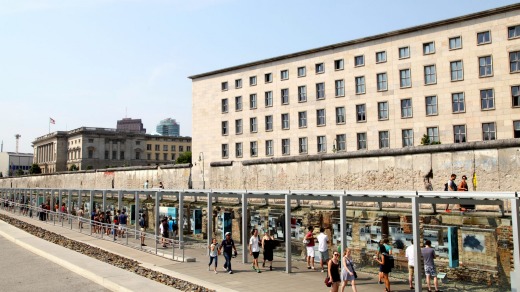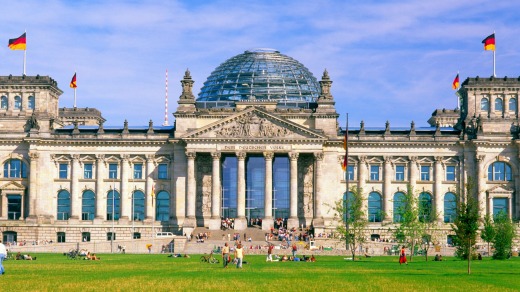A short film shows off the culture and flair that exudes the German capital. Video by the New York Times.
On the morning of David Bowie's 66th birthday he released a new single, Where are we now?, his first in 10 years. Without prelude or promotion the reflective song about Bowie's time in Berlin appeared on iTunes. It was Bowie's surprise gift to his fans.
Where are we now? is a fair question to ask about modern Berlin, a city that has been bombed, occupied, divided, reunited and reborn.

"The comeback single opens with the lines – Had to get the train/ from Potsdamer Platz," says Stratman, our guide for the three-hour Bowie Berlin walk. "After 10 years of radio silence Bowie's reference to Berlin in the opening line was a personal message that he still loves us."
I too have arrived by train at Potsdamer Platz, a bustling square resurrected from what was once the death strip between East and West Berlin. After just one day I'm struck with how resourceful Berlin is; not buffed and polished within an inch of its life, but rather renewed and repurposed. While some buildings from the Cold War remain derelict, others have found a second life; there's a nightclub in a power plant; an art gallery in a bunker; a museum in a air-raid shelter, a Michelin-starred restaurant in a former Jewish girls' school, even a public park in an abandoned airport.
It's all gloriously gritty and gutsy and I love it from the moment I arrive. I love its Bohemian, yet unpretentious feel, where freedom and creativity are more revered than labels and luxury brands. I also love the connection Berlin has to a certain rock star.

The mutual love affair began in the 1970s, during Bowie's "Berlin years", the golden period from 1976 to 1979, when he lived in West Berlin to kick his coke habit and focus on music. His best-known single from this period is Heroes, a song about two doomed lovers who meet at the Berlin Wall. "Heroes is our song," Stratman says. "A hymn to our city."
Stratman leads us to the spot that inspired these lyrics – "I, I can remember/ standing, by the wall. And the guns shot over our heads/ and we kissed, as though nothing could fall." Standing in the searing sunshine it is difficult to imagine such dark days, from 1961 to 1989, when at least 141 people where shot and killed by border guards as they tried to cross the wall.
"Bowie had been working inside Hansa Studios when he spied the couple from the window of the control room," Stratman says. "Seeing them kiss gave him the lyrical inspiration he'd been searching for." We learn that Bowie eventually revealed that the clandestine couple were in fact Bowie's manager Tony Visconti and backup singer Antonia Maas who'd been having an affair.

From the "Hero" spot we cross from East to West, a double line of cobblestones marking where the wall once stood, to the legendary Hansa Studios. Since the 1970s, artists like Bowie, Nick Cave and the Bad Seeds, Tangerine Dream, Iggy Pop, U2, Bon Jovi, and Snow Patrol have recorded albums here, all drawn to the unique acoustics of the Meistersaal, with its seven-metre ceilings and herringbone wooden floor. "If you listen to Heroes and close your eyes you can hear the timber," Stratman says.
From Potsdamer Platz we follow the cobblestones to Martin-Gropius-Bau, the former museum of applied arts that stands adjacent to one of the last remaining stretches of wall, a 200-metre remnant that once marked the border between the districts of Mitte (East Berlin) and Kreuzberg (West Berlin). A miserable sweep of grey, it begs the question, "How the hell did this happen?".
"It was just after midnight on 13 August, 1961, when soldiers rolled out the barbed wire, " Stratman says. "In an instant East Germans were no longer allowed into West Berlin." Eventually the barbed wire was replaced with a 3.6 metre, double concrete wall, manned by border guards who'd been given the orders "shoot to kill".
In his new single Bowie references the fall of the wall on November 9, 1989 – "Twenty thousand people/cross Bösebrücke. Fingers are crossed/ just in case". Stratman explains that Bösebrücke Bridge was the spot where the first wave of East Germans, more than 20,000, crossed over on that historic night.
The tour ends at some key sites – the Reichstag building where Bowie held a live concert in 1987, Schöneberg where Bowie and Iggy Pop lived and finally Neues Ufer, the gay café where the pair used to hang out. As interesting as these are, the strength of any music tour isn't the roll call of haunts and hangouts, rather the chance to get under the skin of an unfamiliar place.
Walking in Bowie's footsteps it's easy to see that the Berlin of today is still reinventing itself, just like the musician himself.
TRIP NOTES
MORE INFORMATION
visitberlin.de
GETTING THERE
Cathay Pacific operates several flights per day from Sydney and Melbourne, via Hong Kong, to London and other key European gateways, with codeshare to Berlin. See cathaypacific.com.au
STAYING THERE
Art Luise in historic Mitte offers comfortable rooms; each designed and decorated by an individual artist. Double rooms from €80. See luise-berlin.com
SEE + DO
Berlin Music Tours offers a three-hour Bowie Berlin Tour (€14) and a separate Hansa Studio Tour (from €15-€30 depending on group size). See musictours-berlin.com
DON'T MISS